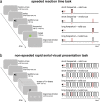Temporal orienting of attention can be preserved in normal aging
- PMID: 27294712
- PMCID: PMC4976797
- DOI: 10.1037/pag0000105
Temporal orienting of attention can be preserved in normal aging
Abstract
Being able to orient our attention to moments in time is crucial for optimizing behavioral performance. In young adults, flexible cue-based temporal expectations have been shown to modulate perceptual functions and enhance behavioral performance. Recent studies with older individuals have reported significant deficits in cued temporal orienting. To investigate the extent of these deficits, the authors conducted 3 studies in healthy old and young adults. For each study, participants completed 2 tasks: a reaction time (RT) task that emphasized speeded responding and a nonspeeded rapid-serial-visual-presentation task that emphasized visual discrimination. Auditory cues indicated the likelihood of a target item occurring after a short or long temporal interval (foreperiod; 75% validity). In the first study, cues indicating a short or a long foreperiod were manipulated across blocks. The second study was designed to replicate and extend the first study by manipulating the predictive temporal cues on a trial-by-trial basis. The third study extended the findings by including neutral cues so that it was possible to separate cueing validity benefits and invalidity costs. In all 3 studies, cued temporal expectation conferred significant performance advantages for target stimuli occurring after the short foreperiod for both old and young participants. Contrary to previous findings, these results suggest that the ability to allocate attention to moments in time can be preserved in healthy aging. Further research is needed to ascertain whether similar neural networks are used to orient attention in time as we age, and/or whether compensatory mechanisms are at work in older individuals. (PsycINFO Database Record
(c) 2016 APA, all rights reserved).
Figures





Similar articles
-
Temporal orienting in Parkinson's disease.Eur J Neurosci. 2021 Apr;53(8):2713-2725. doi: 10.1111/ejn.15114. Epub 2021 Feb 2. Eur J Neurosci. 2021. PMID: 33450082 Free PMC article.
-
The effect of multisensory cues on attention in aging.Brain Res. 2012 Sep 7;1472:63-73. doi: 10.1016/j.brainres.2012.07.014. Epub 2012 Jul 20. Brain Res. 2012. PMID: 22820295 Free PMC article.
-
Multifactorial effects of aging on the orienting of visual attention.Exp Gerontol. 2019 Dec;128:110757. doi: 10.1016/j.exger.2019.110757. Epub 2019 Oct 22. Exp Gerontol. 2019. PMID: 31648007
-
Endogenous temporal and spatial orienting: Evidence for two distinct attentional mechanisms.Psychon Bull Rev. 2015 Aug;22(4):967-73. doi: 10.3758/s13423-014-0750-y. Psychon Bull Rev. 2015. PMID: 25338657
-
Orienting of visual attention in aging.Neurosci Biobehav Rev. 2016 Oct;69:357-80. doi: 10.1016/j.neubiorev.2016.08.010. Epub 2016 Aug 13. Neurosci Biobehav Rev. 2016. PMID: 27531234 Review.
Cited by
-
Behavioral and neural correlates of normal aging effects on motor preparatory mechanisms of speech production and limb movement.Exp Brain Res. 2019 Jul;237(7):1759-1772. doi: 10.1007/s00221-019-05549-4. Epub 2019 Apr 27. Exp Brain Res. 2019. PMID: 31030282 Free PMC article.
-
Phasic and sustained interactions of multisensory interplay and temporal expectation.Sci Rep. 2018 Jul 5;8(1):10208. doi: 10.1038/s41598-018-28495-7. Sci Rep. 2018. PMID: 29976998 Free PMC article.
-
Temporal orienting in Parkinson's disease.Eur J Neurosci. 2021 Apr;53(8):2713-2725. doi: 10.1111/ejn.15114. Epub 2021 Feb 2. Eur J Neurosci. 2021. PMID: 33450082 Free PMC article.
-
Effects of aging on temporal predictive mechanisms of speech and hand motor reaction time.Aging Clin Exp Res. 2018 Oct;30(10):1195-1202. doi: 10.1007/s40520-018-0902-4. Epub 2018 Feb 1. Aging Clin Exp Res. 2018. PMID: 29392576 Free PMC article.
-
Explicit and implicit timing in older adults: Dissociable associations with age and cognitive decline.PLoS One. 2022 Mar 16;17(3):e0264999. doi: 10.1371/journal.pone.0264999. eCollection 2022. PLoS One. 2022. PMID: 35294473 Free PMC article.
References
-
- Brandt J. (1991). The Hopkins Verbal Learning Test: Development of a new memory test with six equivalent forms. Clinical Neuropsychologist, 5, 125–142. 10.1080/13854049108403297 - DOI
Publication types
MeSH terms
Grants and funding
LinkOut - more resources
Full Text Sources
Other Literature Sources
Medical
Molecular Biology Databases

